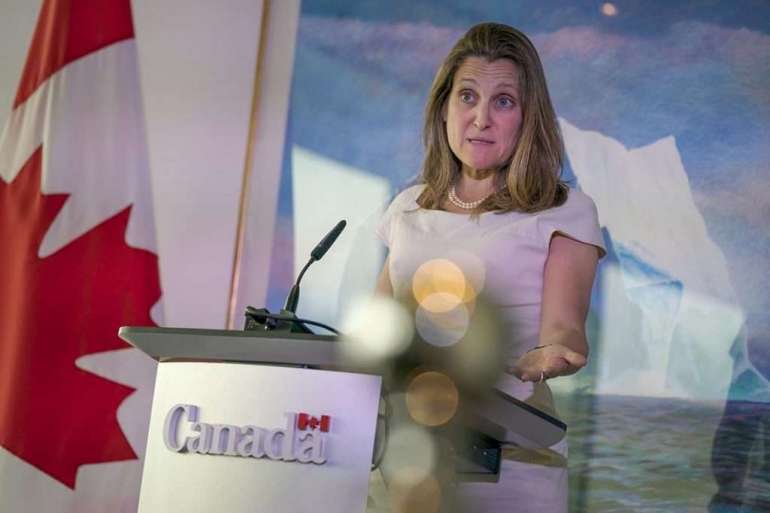How the Trudeau government plans to meet its climate goals

The backdrop: Since coming to power in 2015, Prime Minister Justin Trudeau has stressed his government’s commitment to tackling climate change. With Canada’s economy slowly rebounding from the effects of Covid-19 amid a renewed global interest in climate issues, the government’s first budget in two years seeks to harness the recovery to its environmental policies.
“[The federal budget is] a plan that embraces this moment of global transformation to a green, clean economy,” said Freeland in her budget speech. “In 2021, job growth means green growth.”
Another senior official summed up the government’s thinking: “Climate change is now an innovation and a jobs opportunity.”
Here’s how the Trudeau government plans to meet its climate goals.
Direct spending: As part of the government’s stated goal of cutting Canada’s carbon dioxide emissions to net zero by 2050, while also pursuing a more activist role in guiding the economy, Ottawa is pumping C$5 billion over seven years into the Net Zero Accelerator.
The program, announced in December with an initial C$3 billion in funding, aims to cajole Canadian companies in traditional sectors to reduce their carbon footprints, whether that’s by incentivizing large emitters like oil and steel producers to decarbonize, or spurring auto and aerospace manufacturers to adopt clean technologies.
In the same vein of steering private industries to pursue actions the Liberal government deems worthy, Ottawa will also make C$1 billion available over five years “to help draw in private sector investment” to Canada’s clean technology sector.
One of the biggest-ticket new items among the budget’s environmental initiatives aims to fulfill a Liberal promise from the October 2019 election to conserve 25 percent of Canada’s oceans and lands by 2025. The federal government plans to spend C$2.3 billion over five years to conserve up to one million square kilometers of land and inland waterways. The government also vows to create “thousands of jobs” through its “historic investments in Canada’s natural legacy” but offers no specifics.
Tax cuts: In a budget big on maximizing tax revenue, one group will see a smaller tax bill, at least temporarily — manufacturers of zero-emission technologies. It’s a wide umbrella that includes manufacturers of wind turbines, solar panels, electric vehicles, batteries and fuel cells as well as biofuel and green hydrogen producers.
Companies that earn at least 10 percent of their total gross revenue in Canada from eligible zero-emission efforts can get a 50 percent on their corporate and small business income tax rates, though the tax break will start to phase out in 2029 and will be eliminated by 2032.
Home is where the green is: Building on a program announced in the 2020 Fall Economic Statement to encourage homeowners and landlords to carry out energy-efficient upgrades, Ottawa plans to dole out C$4.4 billion in interest free loans of up to C$40,000 each to homeowners to conduct “deep retrofits” like replacing oil furnaces, drafty windows and poor insulation.
Other measures: As expected, Canada plans to tap into the growing demand among global investors for fixed income securities that finance green infrastructure projects and other sustainability initiatives. Canada hopes to raise C$5 billion by issuing green bonds in fiscal 2021-22, which the budget said will “be the first of many green bond issuances.”
With the federal carbon tax passing its last legal hurdle with a thumbs up from the Supreme Court last month, rebate payments to consumers will start to become more visible next year. At the moment, Canadians receive payments as a refundable credit when filing their taxes, but starting in 2022 the money will go out each quarter as regular benefits.
To be determined: A few important components of Ottawa’s climate-related budget measures that could have an outsized impact on Canada’s ability to meet its climate goals still have yet to be nailed down.
There have been many calls from industry, particularly in the oil and gas sector, for Ottawa to introduce a tax credit to encourage carbon capture, utilization and storage (CCUS). Ottawa says an investment tax credit for capital invested in CCUS projects is coming, and that the measure could reduce CO2 emissions by at least 15 megatonnes annually.
However no dollar figure was attached in the budget, which said the final cost is pending a 90-day consultation period with no official start date.
Lastly, with nations around the world implementing different types of carbon pricing, and some countries applying no price on pollution at all on their domestic industries, the government is looking to level the playing field for Canadian businesses. It’s exploring a border carbon adjustment scheme that would apply appropriate levies on imports and exports, though the government says this too will require “a consultation process.”